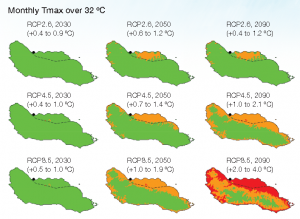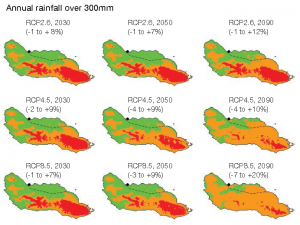Step 7: Assess Climate Change Risk
A. Temperature
The daily minimum temperature results are similar to daily maximum for the Solomon Islands, so just the daily maximums are shown here. The threshold is fairly broad (30–32 °C) and some of the current averages are quite close to this threshold, so the exact choice makes a big difference to the results. Here the top of the range is used: 32°C. The areas where the projected daily maximum temperature range crosses the temperature threshold for cocoa, and where it is above the threshold for three RCPs and three time periods are shown in Figure 4.

categorisation of regions in relation to the 32 °C threshold for growing cocoa
in 2030, 2050 and 2090 under different RCPs (projected ranges of changes in
temperature noted in brackets). Green shows the range is all below threshold,
orange shows that the range crosses the threshold, and red shows the range
is all above the threshold. Dashed line indicates the Guadalcanal Plain. (Click to enlarge)
Looking at this plot in terms of climate vulnerability and risk, the areas in green (temperature range below the threshold) can be interpreted as being fairly low risk of being limited by temperature, areas in orange as potentially at risk, and red areas as being very high risk of being unsuitable. In the Guadalcanal Plain area, the effect of the emissions scenario is very important. Under a very low scenario (RCP2.6), Guadalcanal Plain is possibly too warm if the high end of the model range is followed. Under the other scenarios (RCP4.5 and RCP8.5), temperature could become an important limiting factor to cocoa growing by 2050, and certainly by 2090, even if the lower end of the model range is followed. This shows that there is a clear benefit of mitigation by reducing emissions – it makes the difference between a possible risk and a fairly definite risk that the cocoa farming industry in Solomon Islands becomes unviable in the future. Also, the risk prior to 2050 appears low, so it seems that temperature is unlikely to be a limiting factor to the industry in the near future.
This temperature analysis also provides insights into the potential adaptation options for the industry later in the century, noting more elevated areas are less likely to become too warm for growing cocoa. Possible adaptation responses may therefore include:
- Identifying whether cocoa production in the Guadalcanal Plain could be expanded further up the adjacent slopes of the catchment to follow the change in the optimal temperature growing envelope
- Investigating changes through selective breeding to the crop variety could develop higher temperature tolerance strains of cocoa for production in existing farm areas of Guadalcanal Plain.
B. Rainfall
There is a range of projected changes to average annual rainfall in Solomon Islands – from little change through to increase (Australian Bureau of Meteorology and CSIRO 2014). This range of possibilities means that there is also uncertainty about whether the risk of Guadalcanal becoming too wet will increase or decrease. This uncertainty is seen as a decrease in the green and red areas, but an increase in the orange area in the plots through time and for higher RCPs (Figure 5).

relation to the 1250–3000 mm limits for growing cocoa in 2050 and 2090 under
different RCPs (projected ranges of changes in rainfall noted in brackets). Green
shows the range is all below threshold, orange shows that the range crosses
the threshold, and red shows the range is all above the threshold. Dashed line
indicates the Guadalcanal Plain. (Click to enlarge)
The increase in the orange area shows that a greater area may become too wet or too dry for growing cocoa, but there is a lack of agreement in the projections on this. The region of Guadalcanal Plain where cocoa is now grown shows relatively lower potential risk than other areas of Solomon Islands (i.e. which remains green), except in 2090 and especially under RCP8.5. This suggests that average annual rainfall might not become a limiting factor in future.
It must be acknowledged that rainfall projections have lower confidence compared to temperature projections, so changes outside the projected range are possible. This means that specific adaptation strategies with limited flexibility to deal with this uncertainty in climate risk are probably not appropriate, rather more flexible strategies are preferred together with ongoing monitoring and assessment of the issues.
C. Fungal disease
Rainfall projections are uncertain but suggest that average annual rainfall may stay similar to today or may increase in the long term but is less likely to decrease strongly. Since Guadalcanal Plain already experiences risks from fungal disease partly due to existing rainfall patterns, then these rainfall projections suggest that this risk is very likely to remain, and possibly could become more intense or affect more areas in the future. This means that the industry is likely to continue needing to manage fungal disease using techniques such as pruning into the future, especially in wet years.
D. Extreme rainfall, flooding and dry spells
At the dry end of rainfall projections under a high emissions scenario by 2090, there could be a small increase in the average occurrence of dry spells (runs of more than three months below 100 mm rainfall). Under these circumstances the average climate could feature these conditions in a small area in western Guadalcanal Plain (not shown), but this is only a possibility under the strongest change case, and it is not a very likely case.
The results of the average climate don’t show the effect of bad years, which needs an analysis of variability including dry years and wet years, and accounting for projected changes to rainfall variability as well as change to the average. Data from Australian Bureau of Meteorology and CSIRO (2014) shows that for the Solomon Islands meteorological drought (an index based only on rainfall) is projected to decrease in frequency and duration, with possibly the exception of extreme droughts, which might increase. This suggests that the projected change in average conditions is not likely to lead to an increase in risk to cocoa growing from dry months but increases in extreme events or extreme drought years may have important impacts.
The frequency and intensity of extreme rainfall events are projected to increase in the Solomon Islands (Australian Bureau of Meteorology and CSIRO 2014). Extreme wet days are projected to increase, where the 1-in- 20-year event could become a 1-in- 9-year event under moderate climate change (RCP2.6), or a 1-in-4-year event under a worst-case emissions scenario (RCP8.5) by 2090. Under these conditions, cocoa farmers in Guadalcanal Plain will likely experience increased risk from localised flooding and damage to plant flowering.
Reference
Australian Bureau of Meteorology and CSIRO (2014). Climate Variability, Extremes and Change in the Western Tropical Pacific: New Science and Updated Country Reports. Pacific-Australia Climate Change Science and Adaptation Planning Program Technical Report. Australian Bureau of Meteorology and Commonwealth Scientific and Industrial Research Organisation (CSIRO), Melbourne, Australia
